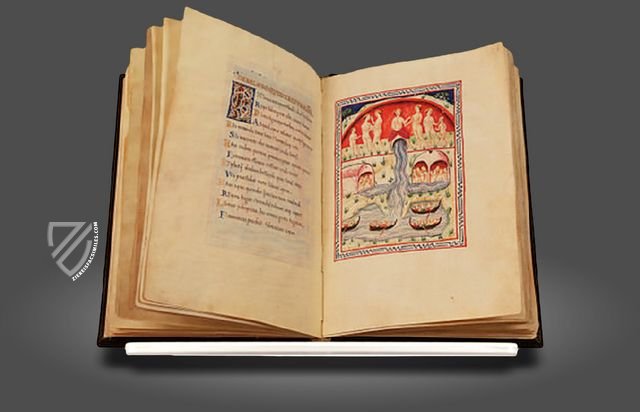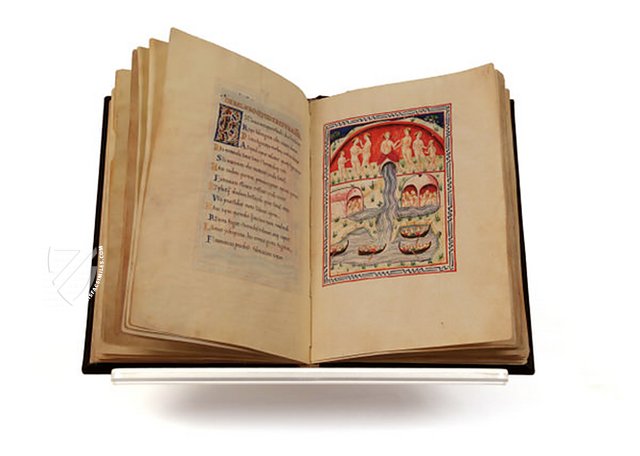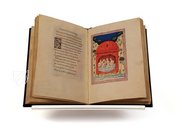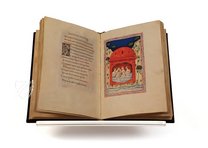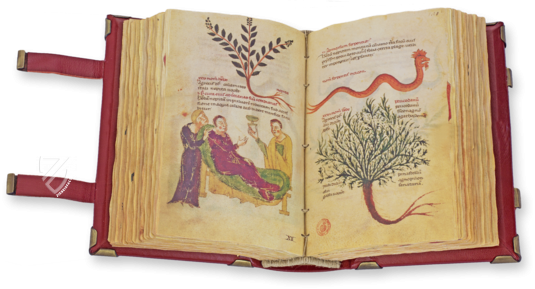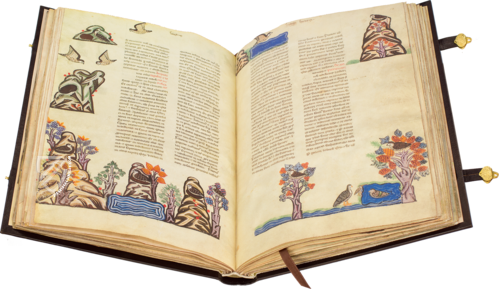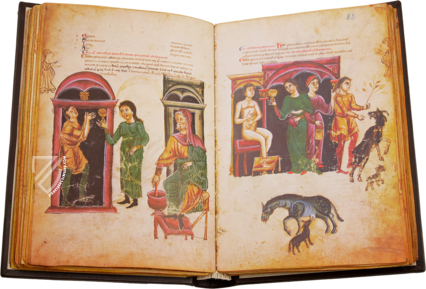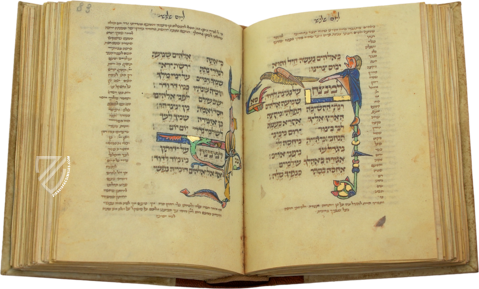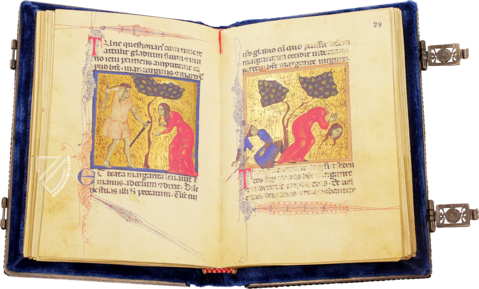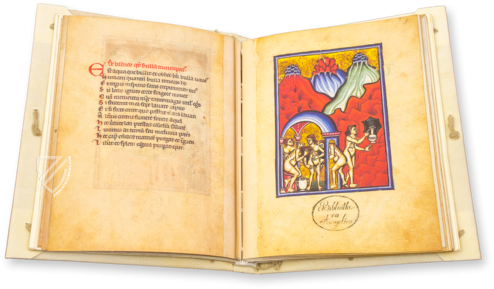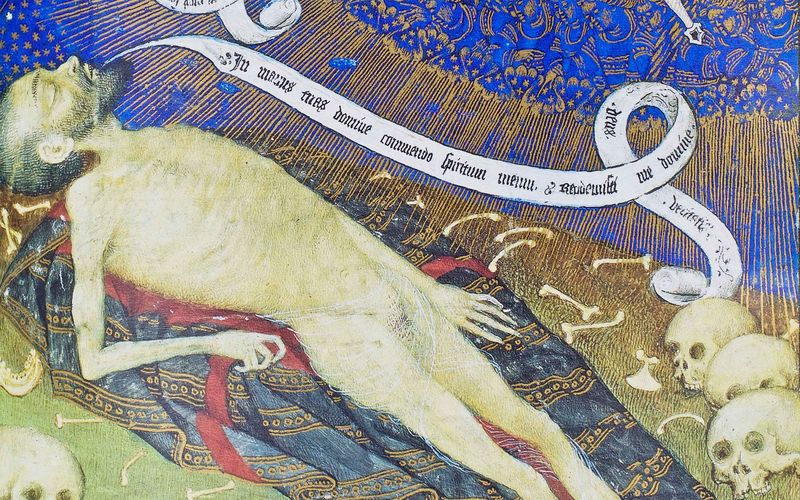De Balneis Puteoli - Pietro da Eboli
(3,000€ - 7,000€)
The manuscript De Balneis Puteoli by Pietro da Eboli is an exciting and valuable testimony to the scientific medicine and Italian illumination of the 15th century. As the first treatise about healing waters, it collects a description of 35 hot springs around Pozzuoli on the Gulf of Naples and their medicinal healing effects. The explanations are richly illustrated with numerous marvelously designed initials and gorgeous miniatures. These show the individual springs and the manner of their use. The treatise by Pietro da Eboli from the 13th century was supplemented in the manuscript by a medical work from the hand of Arnaldus de Villanova, a contemporary of the author and a famous Spanish doctor and diplomat. The De Balneis Puteoli manuscript thus appears as a synthesis of the arts and offers an impressively vivid glimpse into the world of the Italian therapeutic baths of the 13th century.
De Balneis Puteoli - Pietro da Eboli
The manuscript De Balneis Puteoli by Pietro da Eboli is an exciting and valuable testimony to the scientific medicine and Italian illumination of the 15th century. As the first treatise about healing waters it collects a description of 35 hot springs around Pozzuoli on the Gulf of Naples and their medicinal healing effect. The explanations are richly illustrated with numerous marvelously designed initials and gorgeous miniatures. These show the individual springs and the manner of their use. The treatise by Pietro da Eboli from the 13th century was supplemented in the manuscript by a medical work from the hand of Arnaldus de Villanova, a contemporary of the author and a famous Spanish doctor and diplomat. The De Balneis Puteoli thus represents a synthesis of the arts and offers an impressively vivid glimpse into the world of the Italian therapeutic baths of the 13th century.
Famous Therapeutic Baths in the Gulf of Naples
The baths of Pozzuoli have been known for their medicinal benefits since at least the 13th century. The city of Pozzuoli lies to the west of Naples in the volcanic region and can thus boast numerous hot springs in its environs. These were used since antiquity as thermal baths and healing springs for medical applications. In the tradition of Galen, various ailments and illnesses were cured in the hot springs. Contributing measurably to the fame of Pozzuoli in the 13th century was Pietro da Eboli’s writings from the time around 1220, which is simultaneously a scientific treatise and a didactic work.
A Medicinal Treatise by Famous Doctors and Poets
The manuscript with the title of Nomina et virtutes balneorum Putheoli et Baiarum is housed today in Valencia. The author of this first treaty about healing springs was Pietro da Eboli, an Italian author and chronicler of the 13th century. Eboli recorded, among others, a poem of praise in honor of Holy Roman Emperor Henry VI, which earned him the highest honors, and a laudation of Holy Roman Emperor Friedrich Barbarossa. His work concerning the healing baths of Pozzuoli enjoyed wide circulation and numerous translations, which attest to the popularity of the document. In the manuscript, which presumably originated from Naples at the end of the 15th century, the text of Pietro da Eboli is supplemented by the Tabula super balneis Puteoli by Arnaldus de Villanova (ca. 1240–1311). This conjunction makes the manuscript unique. Arnaldus de Villanova was a Spanish doctor, diplomat, and church reformer and was active, among others, as a personal physician of various popes and Holy Roman Emperor Friedrich II. His Tabula offers an assortment various illnesses in alphabetical order. In this way, one could find out what spring and what bath were recommended for the cure of the sought-after illness. Additionally, the manuscript contains at its beginning a dedicated poem in honor of the Duke of Calabria and King of Naples, Alfonso II, and an elegy at the end.
Lifelike Illustrations of the Poetic Descriptions
The 76 pages of the manuscript are richly adorned with 36 marvelous illustrations. These supplement the descriptions of the 35 baths around Pozzuoli. The full-page miniatures in brightly-colored frames show the springs and the manner of the cure. With a lot of naked skin, many nudes of bathers in the water were illustrated in the explanations. The bathers in the depictions either find themselves in framed pools outdoors or in bath houses, sometimes even in tubs or tanks. They wash off their bodies, some even submerge themselves, others relax after the bath by lying in a tent. The scenes are imbedded in a harmonious landscape and present themselves as marvelously lifelike scenes. Additionally, gorgeous initials adorn the typeface of the poem. Bright trim, gold leaf, and ornamental braids combine with one another in impressive splendor. This conjunction of medical explanation, entertaining-educational treatise, and gorgeous illustrations make the De Balneis Puteoli manuscript a true gem of medieval book art.
Codicology
- Alternative Titles
- Petrus de Ebulo: De balneis Puteolanis
Arnoldus de Villa Nova: Tabula super balneis Puteoli
Über die Bäder von Pozzuoli
Nomina et Virtutes Balneorum Putheoli et Baiarum et Tabula Super Balneis Puteoli
Petrus de Ebulo De Balneis Puteolanis
De Balneis Puteoli - Size / Format
- 76 pages / 30.0 × 21.9 cm
- Origin
- Italy
- Date
- Before 1494
- Epochs
- Style
- Language
- Script
- Humanistic
- Artist / School
- Arnaldus de Villanova (d. 1311) (author)
Peter of Eboli (d. 1220) (author) - Previous Owners
- Alfonso II of Naples, Duke of Calabria (1448–95)
Library of the Dukes of Calabria
Monastic Library of San Miguel de los Reyes
#1 De Balneis Puteoli - Pietro da Eboli
Languages: English, Spanish
(3,000€ - 7,000€)
- Treatises / Secular Books
- Apocalypses / Beatus
- Astronomy / Astrology
- Bestiaries
- Bibles / Gospels
- Chronicles / History / Law
- Geography / Maps
- Saints' Lives
- Islam / Oriental
- Judaism / Hebrew
- Single Leaf Collections
- Leonardo da Vinci
- Literature / Poetry
- Liturgical Manuscripts
- Medicine / Botany / Alchemy
- Music
- Mythology / Prophecies
- Psalters
- Other Religious Books
- Games / Hunting
- Private Devotion Books
- Other Genres
- Afghanistan
- Armenia
- Austria
- Belgium
- Belize
- Bosnia and Herzegovina
- China
- Colombia
- Costa Rica
- Croatia
- Cyprus
- Czech Republic
- Denmark
- Egypt
- El Salvador
- Ethiopia
- France
- Germany
- Greece
- Guatemala
- Honduras
- Hungary
- India
- Iran
- Iraq
- Israel
- Italy
- Japan
- Jordan
- Kazakhstan
- Kyrgyzstan
- Lebanon
- Liechtenstein
- Luxembourg
- Mexico
- Morocco
- Netherlands
- Palestine
- Panama
- Peru
- Poland
- Portugal
- Romania
- Russia
- Serbia
- Spain
- Sri Lanka
- Sweden
- Switzerland
- Syria
- Tajikistan
- Turkey
- Turkmenistan
- Ukraine
- United Kingdom
- United States
- Uzbekistan
- Vatican City
- A. Oosthoek, van Holkema & Warendorf
- Aboca Museum
- Ajuntament de Valencia
- Akademie Verlag
- Akademische Druck- u. Verlagsanstalt (ADEVA)
- Aldo Ausilio Editore - Bottega d’Erasmo
- Alecto Historical Editions
- Alkuin Verlag
- Almqvist & Wiksell
- Amilcare Pizzi
- Andreas & Andreas Verlagsbuchhandlung
- Archa 90
- Archiv Verlag
- Archivi Edizioni
- Arnold Verlag
- ARS
- Ars Magna
- ArtCodex
- AyN Ediciones
- Azimuth Editions
- Badenia Verlag
- Bärenreiter-Verlag
- Belser Verlag
- Belser Verlag / WK Wertkontor
- Benziger Verlag
- Bernardinum Wydawnictwo
- BiblioGemma
- Biblioteca Apostolica Vaticana (Vaticanstadt, Vaticanstadt)
- Bibliotheca Palatina Faksimile Verlag
- Bibliotheca Rara
- Boydell & Brewer
- Bramante Edizioni
- Bredius Genootschap
- Brepols Publishers
- British Library
- C. Weckesser
- Caixa Catalunya
- Canesi
- CAPSA, Ars Scriptoria
- Caratzas Brothers, Publishers
- Carus Verlag
- Casamassima Libri
- Centrum Cartographie Verlag GmbH
- Chavane Verlag
- Christian Brandstätter Verlag
- Circulo Cientifico
- Club Bibliófilo Versol
- Club du Livre
- CM Editores
- Collegium Graphicum
- Collezione Apocrifa Da Vinci
- Comissão Nacional para as Comemorações dos Descobrimentos Portugueses
- Coron Verlag
- Corvina
- CTHS
- D. S. Brewer
- Damon
- De Agostini/UTET
- De Nederlandsche Boekhandel
- De Schutter
- Deuschle & Stemmle
- Deutscher Verlag für Kunstwissenschaft
- DIAMM
- Droz
- E. Schreiber Graphische Kunstanstalten
- Ediciones Boreal
- Ediciones Grial
- Ediclube
- Edições Inapa
- Edilan
- Editalia
- Edition Deuschle
- Edition Georg Popp
- Edition Leipzig
- Edition Libri Illustri
- Editiones Reales Sitios S. L.
- Éditions de l'Oiseau Lyre
- Editions Medicina Rara
- Editorial Casariego
- Editorial Mintzoa
- Editrice Antenore
- Editrice Velar
- Edizioni Edison
- Egeria, S.L.
- Eikon Editores
- Electa
- Emery Walker Limited
- Enciclopèdia Catalana
- Eos-Verlag
- Ephesus Publishing
- Ernst Battenberg
- Eugrammia Press
- Extraordinary Editions
- Fackelverlag
- Facsimila Art & Edition
- Facsimile Editions Ltd.
- Facsimilia Art & Edition Ebert KG
- Faksimile Verlag
- Feuermann Verlag
- Folger Shakespeare Library
- Franco Cosimo Panini Editore
- Friedrich Wittig Verlag
- Fundación Hullera Vasco-Leonesa
- G. Braziller
- Gabriele Mazzotta Editore
- Gebr. Mann Verlag
- Gesellschaft für graphische Industrie
- Getty Research Institute
- Giovanni Domenico de Rossi
- Giunti Editore
- Graffiti
- Grafica European Center of Fine Arts
- Guido Pressler
- Guillermo Blazquez
- Gustav Kiepenheuer
- H. N. Abrams
- Harrassowitz
- Harvard University Press
- Helikon
- Hendrickson Publishers
- Henning Oppermann
- Herder Verlag
- Hes & De Graaf Publishers
- Hoepli
- Holbein-Verlag
- Houghton Library
- Hugo Schmidt Verlag
- Idion Verlag
- Il Bulino, edizioni d'arte
- ILte
- Imago
- Insel Verlag
- Insel-Verlag Anton Kippenberger
- Instituto de Estudios Altoaragoneses
- Instituto Nacional de Antropología e Historia
- Introligatornia Budnik Jerzy
- Istituto dell'Enciclopedia Italiana - Treccani
- Istituto Ellenico di Studi Bizantini e Postbizantini
- Istituto Geografico De Agostini
- Istituto Poligrafico e Zecca dello Stato
- Italarte Art Establishments
- Jan Thorbecke Verlag
- Johnson Reprint Corporation
- Josef Stocker
- Josef Stocker-Schmid
- Jugoslavija
- Karl W. Hiersemann
- Kasper Straube
- Kaydeda Ediciones
- Kindler Verlag / Coron Verlag
- Kodansha International Ltd.
- Konrad Kölbl Verlag
- Kurt Wolff Verlag
- La Liberia dello Stato
- La Linea Editrice
- La Meta Editore
- Lambert Schneider
- Landeskreditbank Baden-Württemberg
- Leo S. Olschki
- Les Incunables
- Liber Artis
- Library of Congress
- Libreria Musicale Italiana
- Lichtdruck
- Lito Immagine Editore
- Lumen Artis
- Lund Humphries
- M. Moleiro Editor
- Maison des Sciences de l'homme et de la société de Poitiers
- Manuscriptum
- Martinus Nijhoff
- Maruzen-Yushodo Co. Ltd.
- MASA
- Massada Publishers
- McGraw-Hill
- Metropolitan Museum of Art
- Militos
- Millennium Liber
- Müller & Schindler
- Nahar - Stavit
- Nahar and Steimatzky
- National Library of Wales
- Neri Pozza
- Nova Charta
- Oceanum Verlag
- Odeon
- Orbis Mediaevalis
- Orbis Pictus
- Österreichische Staatsdruckerei
- Oxford University Press
- Pageant Books
- Parzellers Buchverlag
- Patrimonio Ediciones
- Pattloch Verlag
- PIAF
- Pieper Verlag
- Plon-Nourrit et cie
- Poligrafiche Bolis
- Presses Universitaires de Strasbourg
- Prestel Verlag
- Princeton University Press
- Prisma Verlag
- Priuli & Verlucca, editori
- Pro Sport Verlag
- Propyläen Verlag
- Pytheas Books
- Quaternio Verlag Luzern
- Reales Sitios
- Recht-Verlag
- Reichert Verlag
- Reichsdruckerei
- Reprint Verlag
- Riehn & Reusch
- Roberto Vattori Editore
- Rosenkilde and Bagger
- Roxburghe Club
- Salerno Editrice
- Saltellus Press
- Sandoz
- Sarajevo Svjetlost
- Schöck ArtPrint Kft.
- Schulsinger Brothers
- Scolar Press
- Scrinium
- Scripta Maneant
- Scriptorium
- Shazar
- Siloé, arte y bibliofilia
- SISMEL - Edizioni del Galluzzo
- Sociedad Mexicana de Antropología
- Société des Bibliophiles & Iconophiles de Belgique
- Soncin Publishing
- Sorli Ediciones
- Stainer and Bell
- Studer
- Styria Verlag
- Sumptibus Pragopress
- Szegedi Tudomànyegyetem
- Taberna Libraria
- Tarshish Books
- Taschen
- Tempus Libri
- Testimonio Compañía Editorial
- Thames and Hudson
- The Clear Vue Publishing Partnership Limited
- The Facsimile Codex
- The Folio Society
- The Marquess of Normanby
- The Richard III and Yorkist History Trust
- Tip.Le.Co
- TouchArt
- TREC Publishing House
- TRI Publishing Co.
- Trident Editore
- Tuliba Collection
- Typis Regiae Officinae Polygraphicae
- Union Verlag Berlin
- Universidad de Granada
- University of California Press
- University of Chicago Press
- Urs Graf
- Vallecchi
- Van Wijnen
- VCH, Acta Humaniora
- VDI Verlag
- VEB Deutscher Verlag für Musik
- Verlag Anton Pustet / Andreas Verlag
- Verlag Bibliophile Drucke Josef Stocker
- Verlag der Münchner Drucke
- Verlag für Regionalgeschichte
- Verlag Styria
- Vicent Garcia Editores
- W. Turnowski Ltd.
- W. Turnowsky
- Waanders Printers
- Wiener Mechitharisten-Congregation (Wien, Österreich)
- Wissenschaftliche Buchgesellschaft
- Wissenschaftliche Verlagsgesellschaft
- Wydawnictwo Dolnoslaskie
- Xuntanza Editorial
- Zakład Narodowy
- Zollikofer AG

